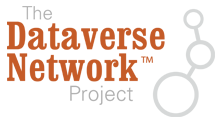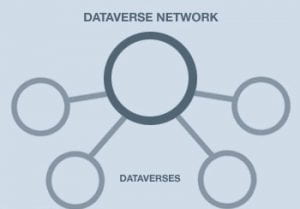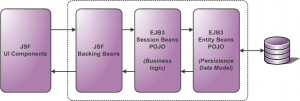Please note: This content was originally hosted at http://people.iq.harvard.edu/~pdurbin but that site has gone dark and I wanted to preserve what I wrote in the timeframe between December 2012 and May 2013. I had just begun working as a developer for Dataverse and this was my write up of what Dataverse was back then. I was getting oriented with the features offered, the code, the community, and the ecosystem. Throughout you’ll see references to “DVN” because that’s what we called the Dataverse software back then. It stood for “Dataverse Network” and we called it “DVN 3.” The software has since been rewritten and rebranded as just “Dataverse”.
It’s surprising how many of the links in the post no longer work. We managed to get the domain “dataverse.org” (replacing “thedata.org”) and we did a rewrite, which included some rebranding. Here are updated links:
- Dataverse home page: http://dataverse.org
- Harvard’s production installation of Dataverse: https://dataverse.harvard.edu
- What a “dataverse” is: http://guides.dataverse.org/en/4.6/user/dataverse-management.html
- Visualizing data in Dataverse: http://guides.dataverse.org/en/4.6/user/data-exploration/tworavens.html
- Utah study?
- Subset and analysis: http://guides.dataverse.org/en/4.6/user/data-exploration/tworavens.html
- Demo Dataverse: https://demo.dataverse.org
- Dataverse code: https://github.com/IQSS/dataverse
- Dataverse issue tracker: https://github.com/IQSS/dataverse/issues
- Dataverse Installation Guide: http://guides.dataverse.org/en/4.6/installation
- Dataverse support address: support@dataverse.org
- The Vagrantfile for Dataverse is now at the root of https://github.com/IQSS/dataverse
- Dataverse Dev Guide: http://guides.dataverse.org/en/4.6/developers
- Dataverse bugs assigned to me: https://github.com/IQSS/dataverse/issues/assigned/pdurbin
- Dataverse on Twitter: https://twitter.com/dataverseorg
- Dataverse IRC logs: http://irclog.iq.harvard.edu/dataverse/today
- IQSS products: http://www.iq.harvard.edu/product-development
- Center for Astrophysics Dataverse: https://dataverse.harvard.edu/dataverse/cfa
- Rather than bugz.hul we use Service Now
Ok, on to the old post, last updated in 2013:
Philip Durbin, Software Developer
- open source
- data
- collaboration
- community
I work on The Dataverse Network Project ( http://thedata.org ), an open source web application for sharing, citing, analyzing, and preserving research data.
If you have research data… you can host it for FREE at http://thedata.harvard.edu 🙂
A “dataverse” is simply a container, a place to upload your data: http://en.wikipedia.org/wiki/dataverse
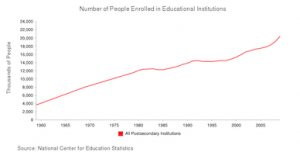
If you have time series data (on recession trends for example) you have your DVN visualize it (as above) by following http://guides.thedata.org/book/data-visualization
DVN can provide descriptive statistics of your data. Here’s the age variable from a census of Utah in 1880:
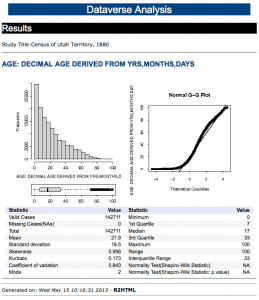
On tabular and network data, you can perform statistical analysis by following http://guides.thedata.org/book/subset-and-analysis
http://dvn-demo.iq.harvard.edu is a great place to test out the DVN software. Go ahead and upload some data and play around. 🙂
The Dataverse Network (DVN) software is open source. The code is hosted at https://github.com/iqss/dvn and bugs are tracked at http://redmine.hmdc.harvard.edu/projects/dvn
Your institution is welcome to download and set up their own Dataverse Network installation on their own server. If you need help installing your DVN, please email us at support@thedata.org
If you don’t have a server handy, you can try installing a DVN on a virtual machine on your laptop with https://github.com/pdurbin/dvn-vagrant or https://github.com/dvn/dvn-install-demo . Please don’t use this in production. 🙂


If you’d like to contribute code, please see http://devguide.thedata.org
If you’d like to work on bugs that have been assigned to me, please be my guest. 🙂
I tend to work on the business logic:
(Image from http://blog.xebia.fr/2009/06/03/seam-repenser-larchitecture-des-applications-web/ )
If you’d like to get involved with the DVN community, you can check out our tweets at http://twitter.com/thedataorg or join the mailing list at http://groups.google.com/group/dataverse-community
I started a Google+ page for DVN and I sometimes chat with people in #dvn on Freenode: http://irclog.iq.harvard.edu/dvn
The Dataverse Network is one of many products developed by The Institute for Quantitative Social Science (IQSS) at Harvard University: http://www.iq.harvard.edu/products
The source for many IQSS projects can be found under https://github.com/iqss but see http://iqss.github.com/github-at-iqss for a more complete list.
![]()

Both DVN installations at Harvard (the IQSS Dataverse Network and the Harvard-Smithsonian Astronomy Dataverse Network) are ably hosted by Harvard University Information Technology (HUIT) Library Technology Services (LTS): http://library.harvard.edu/project-update-dataverse
From time to time I check http://bugz.hul.harvard.edu/buglist.cgi?product=Dataverse for anything LTS might need from me.

http://thedata.org lists Dataverse Networks around the world.

This web page is written in Markdown and rendered into HTML with Jekyll. The source can be found at https://git.huit.harvard.edu/pdurbin/pdurbiniq
My personal website is http://greptilian.com
